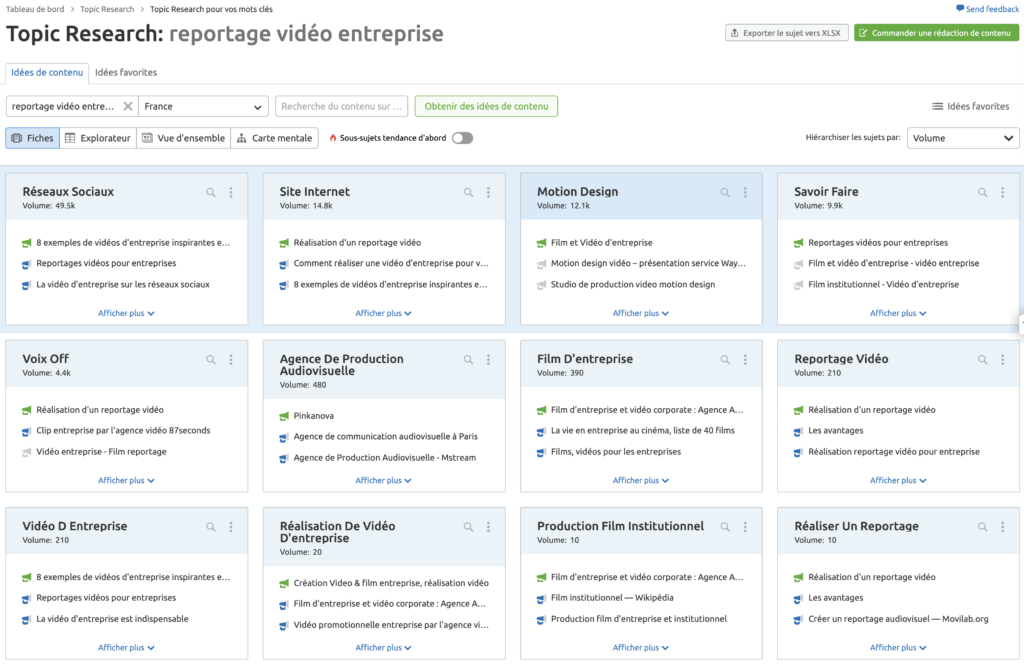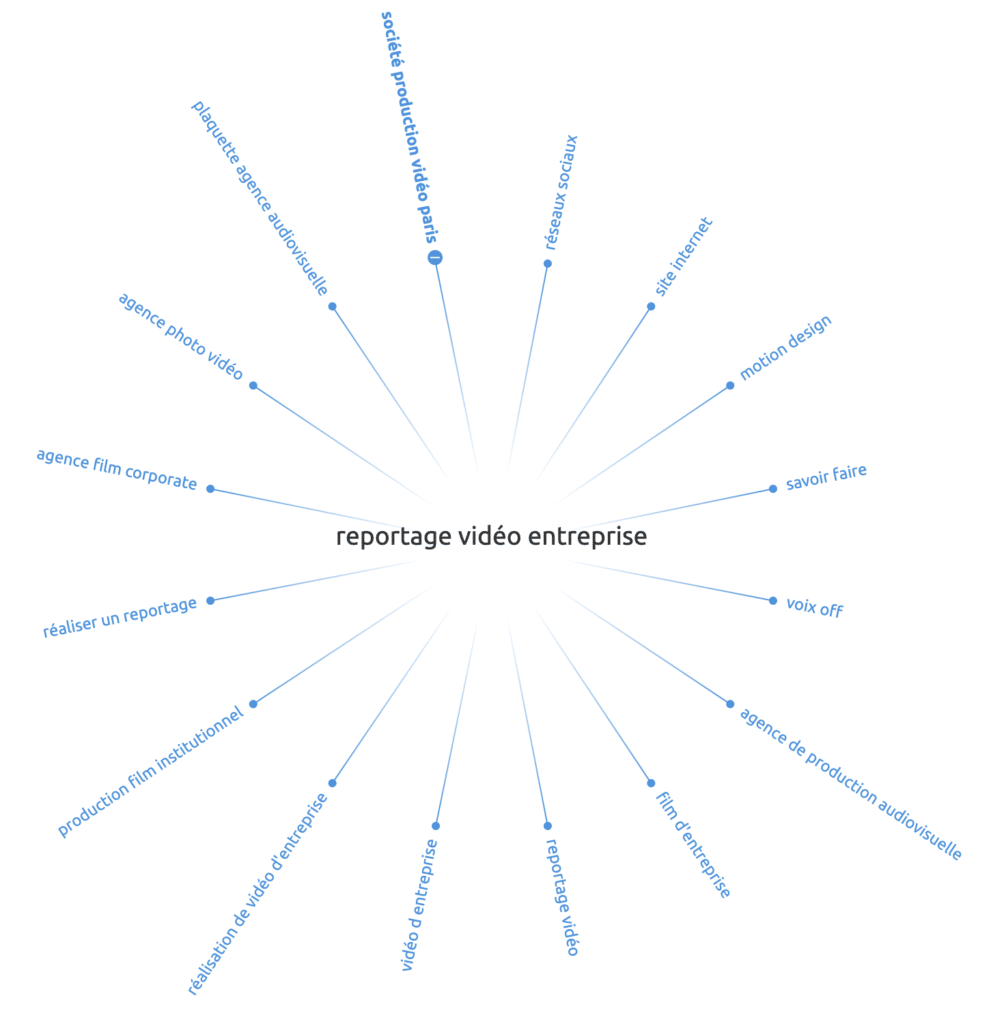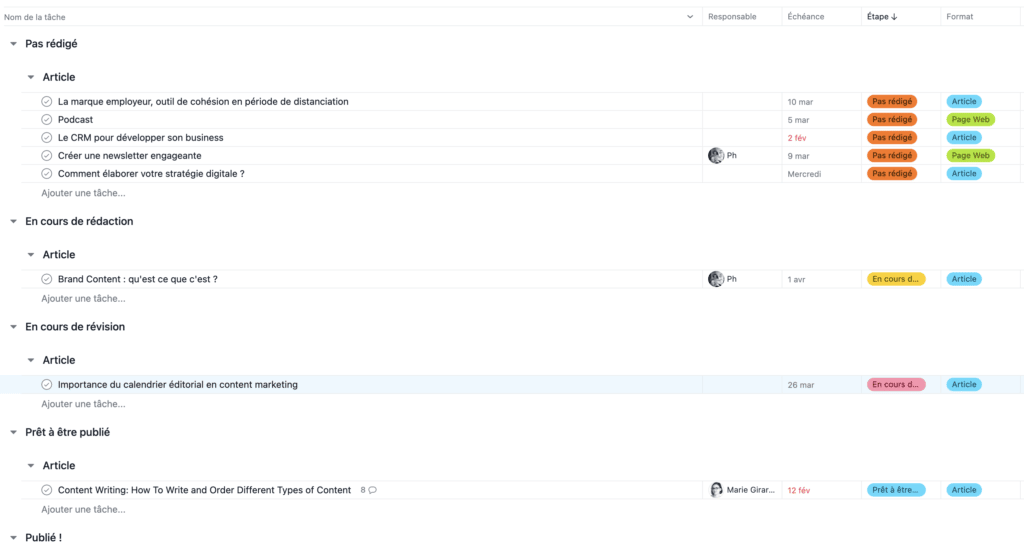
Vous en êtes conscient, internet représente aujourd’hui un formidable réservoir de clientèle pour votre entreprise. Mais encore faut-il arriver à vous démarquer parmi les myriades de concurrents qui inondent la Toile ! Quelle que soit votre activité, le marketing de contenu est donc indispensable pour attirer les prospects et les transformer en clients fidèles.
Quelles sont les règles pour créer un contenu rédactionnel de qualité ? Comment mettre en place et externaliser votre production de contenu ? Bref, comment élaborer sa stratégie de content marketing ? Voici nos conseils.
Ce n’est pas un hasard si 87 % des webmarketeurs utilisent le contenu pour guider l’acheteur à travers le tunnel de vente. Élément essentiel de votre stratégie de communication, la création de contenu rédactionnel répond à un double objectif :
Il existe de nombreux formats de contenus textuels. Les plus couramment utilisés, notamment dans le secteur B2B, sont :
Chaque type de contenu permet d’atteindre votre cible à un stade particulier du parcours client et vise à déclencher une action : partage sur les réseaux sociaux, inscription à un événement, demande de devis, téléchargement d’une plaquette informative… Tout l’enjeu consiste à faire progresser le prospect jusqu’à l’objectif final : la conclusion de la transaction. Votre stratégie éditoriale s’inscrit donc dans une démarche long terme.
Avant la phase de rédaction à proprement parler, il est essentiel de mener un travail préparatoire afin de produire un contenu fiable et pertinent pour votre audience. En effet, la diffusion d’informations erronées constitue une perte de crédibilité aux yeux des moteurs de recherche et de votre public.
Selon une étude de l’agence Hill Holliday, 59 % des clients boycottent les marques qui utilisent de fausses informations. À l’inverse, 64 % des consommateurs se déclarent plus susceptibles d’effectuer des achats auprès d’une entreprise qui fait preuve d’honnêteté dans son contenu de marque.
Un contenu factuel et réaliste contribue à vous poser en expert et à asseoir votre autorité dans votre domaine d’activité. La phase de recherche préliminaire permet de guider le processus de création et d’éviter ainsi de gaspiller votre budget marketing.
Voici les différentes étapes que vous devez réaliser :
Réfléchissez aux objectifs commerciaux que vous souhaitez atteindre afin de déterminer le type de contenu et le style d’écriture les plus adaptés. Par exemple, si vous désirez augmenter le trafic organique vers votre site, vous devez privilégier l’emploi de mots-clés à fort volume de recherche. S’il s’agit de convertir vos lecteurs en prospects, vous pouvez utiliser les techniques du copywriting pour les convaincre de télécharger un lead magnet (contenu téléchargeable en échange des coordonnées).
Le « buyer persona » est une représentation abstraite de votre client idéal. Ce personnage imaginaire possède généralement un prénom ainsi que des caractéristiques socio-professionnelles et psychologiques.
Lorsque l’on rédige un contenu, il est primordial de savoir à qui l’on s’adresse. L’utilisation d’un persona permet de se concentrer sur une cible précise, et d’employer ainsi le langage et les arguments qui feront mouche auprès de ce type de client. C’est la base d’un marketing automation performant.
L’élaboration du persona se base sur les résultats d’études de marché, ainsi que sur les profils de vos clients réels. Pour cela, vous pouvez par exemple :
Un bon contenu est un contenu qui répond aux attentes des internautes. Il est donc essentiel de bien identifier l’intention de recherche de votre cible. On distingue quatre types d’intentions de recherche, qui se traduisent par l’emploi de termes spécifiques dans la requête :
Là encore, c’est l’intention de recherche qui doit guider le choix du format de contenu : un article de blog répondra parfaitement à une recherche informationnelle, tandis qu’une fiche-produit détaillée sera plus adaptée pour une recherche transactionnelle.
À l’heure actuelle, la rédaction de contenu est étroitement liée au référencement naturel. Un contenu optimisé selon les règles du SEO (search engine optimization) a plus de chances de se positionner dans les premiers résultats des moteurs de recherche, et donc d’être lu. À l’inverse, un contenu dupliqué ou de faible qualité risque d’être pénalisé par Google et rétrogradé en troisième ou quatrième page. Votre site internet perdra en visibilité.
Vous devez ainsi identifier les mots-clés pertinents pour votre activité et sur lesquels vous souhaitez que votre cible vous trouve. Certains outils gratuits ou payants permettent de classer les mots-clés en fonction du volume de recherche et de la concurrence. Plus une requête est concurrentielle, plus il sera difficile de bien se positionner dessus, les premières places étant souvent occupées par des sites d’autorité.

Source : Semrush // Autour de l’Image
L’efficacité de votre content marketing repose sur l’élaboration d’une stratégie de contenu précisant les éléments suivants :
Cette feuille de route fournit un cadre structuré pour créer et diffuser votre contenu sans vous éparpiller.
Prenez le temps de chercher des idées fortes qui impacteront vos lecteurs et généreront des résultats avant de vous lancer tête baissée dans la rédaction web. Pour trouver l’inspiration, vous pouvez :

Source : Semrush // Autour de l’Image

Source : Semrush // Autour de l’Image
Une fois que vous avez clairement défini vos objectifs, vos sujets, les formats de contenu et les canaux de diffusion, vous pouvez élaborer un calendrier éditorial. Très apprécié des créateurs de contenu, des référenceurs et des webmarketeurs en général, cet outil fournit une vision globale des tâches à réaliser.
Pour chaque publication, précisez les éléments suivants :
Vous pouvez vous servir d’un simple tableur Excel, ou bien opter pour un outil spécifique comme Asana, le logiciel de gestion de projets utilisé par Autour de l’Image.

Ce type d’outil collaboratif facilite la communication entre les membres de l’équipe, notamment en période de télétravail. Vous pouvez ainsi superviser le bon déroulement des tâches, même à distance.
Voici quelques conseils pour vous aider à rédiger des textes impactants susceptibles de convertir vos prospects :
Ces conseils sont à adapter en fonction du type de contenu rédigé. Par exemple, pour les newsletters et les emails, la formulation de l’objet est primordiale pour maximiser le taux d’ouverture. Les pages produits seront quant à elles plus attrayantes si elles comportent des éléments visuels, des témoignages clients et des descriptifs détaillés.
Une fois votre contenu publié, n’oubliez pas d’évaluer ses retombées grâce à l’analyse des KPI (indicateurs clés de performance). L’efficacité du contenu est principalement mesurée par le trafic organique (83 %) et les sessions/pages vues (70 %). Les autres indicateurs les plus populaires sont les prospects (66 %) et le taux de conversion (53 %).
Vous l’avez compris, la création d’un contenu de qualité est une tâche complexe et chronophage. Pour vous aider, vous pouvez la confier à un rédacteur en interne, ou faire appel à un prestataire. Selon une étude du Content Marketing Institute, 84 % des entreprises B2B externalisent leur production de contenu.
En effet, l’outsourcing présente un grand nombre d’avantages :
Contrairement aux idées reçues, rédiger pour le web ne se résume pas à bien écrire. Les copywriters professionnels et les rédacteurs web savent choisir les mots, le ton et le style adéquats pour créer un contenu correspondant à votre marque et à vos objectifs marketing. Il constitue votre brand content.
Le marché de la création de contenu se partage entre trois principaux types d’acteurs :
Dans tous les cas, il est conseillé d’étudier les références et le portfolio du prestataire afin de vous faire une idée de ses compétences et des entreprises qui lui ont déjà fait confiance.
Une fois votre choix effectué, il ne vous reste plus qu’à rédiger ou faire rédiger un briefing détaillé précisant les éléments suivants :
Spécialisée dans la communication B2B, l’agence Autour de l’Image vous propose des prestations de rédaction et de copywriting. Nous entrons dans votre univers pour comprendre les codes de votre secteur afin d’établir une stratégie de marketing de contenu cohérente et efficace. Grâce à la création de contenus optimisés, nous rendons votre discours percutant pour toucher vos prospects et clients et favoriser leur engagement.
Vous souhaitez nous confier la production de votre contenu rédactionnel ? Contactez-nous pour discuter de vos besoins !